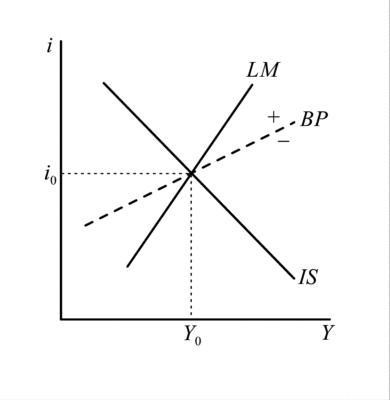From the diagram, one can read the following effects of exogenous changes, for the case shown (which assumes relatively mobile capital and sterilization of exchange market intervention -- see notes below):
| Fiscal expansion
|
|
An increase in government spending (or a tax cut) shifts the IS-curve to the right. With a fixed exchange rate this causes income and the interest rate both to rise. The rise in interest rate attracts a capital inflow that, with relatively mobile capital, is sufficient to create a BOP surplus. With a flexible exchange rate this is an excess demand for domestic currency, which therefore appreciates. The appreciation dampens the increase in both income and the interest rate.
|
| Monetary expansion
|
|
An increase in the money supply shifts the LM curve to the right, raising income and lowering the interest rate. With a fixed exchange rate, both of these changes contribute to BOP deficit. With a flexible rate, this is an excess supply of domestic currency, which therefore depreciates. The depreciation further stimulates income, but dampens the fall in interest rate.
|
| Devaluation
|
|
A devaluation of the otherwise fixed exchange rate stimulates demand for domestic goods shifting the IS-curve to the right, but also shifting the BP curve down and creating a BOP surplus. (This ignores the possibility of a J-curve -- see below.)
|
| Capital Inflow
|
|
An exogenous capital inflow has no effect on IS or LM under a fixed exchange rate, since the central bank is sterilizing its effect on the interest rate. It merely causes a BOP surplus. With a flexible rate, however, this surplus causes an appreciation, which reduces demand and shifts the IS curve to the left. Thus the capital inflow lowers income and the interest rate under a flexible exchange rate.
|

